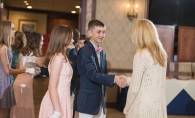¡Hola! Nǐ hǎo!
We’re saying hello: “Hola” is Spanish, and “nǐ hǎo” is Mandarin Chinese. Have you ever wanted to learn a second language? And we don’t mean just a few key phrases for your vacation abroad—we mean full fluency. Thanks to an innovative program in Minnetonka Public Schools, students have the opportunity to be fully immersed in a second language during their school day, learning about language—and culture—in real time.
Why Immersion?
“We studied a variety of [language learning] models as a district,” says Dave Parker, principal at Groveland Elementary School. “The immersion model emerged as the one that … was going to best meet the future needs of our kids in a very global, 21st-century environment.” The goal is for students to reach advanced proficiency ranges in the target languages of Spanish or Mandarin Chinese by the time they graduate from high school, with more intensive language immersion in the early years, while little brains are especially ready to absorb new information. “[Young children] do it with such ease, compared to an adult learning a language,” Parker marvels.
Lee Drolet, principal at Excelsior Elementary, echoes that. “By learning a second language, your brain develops the ability to be more fluid, and a better problem solver.”
The Curriculum
Do immersion students learn the same content as their English-class peers? “We use the same curriculum,” says Parker; it’s printed in Spanish, English and Chinese. “We’ve even completed our Library Media Center collection, so students can go and check out books in their language of choice.”
Parker explains that about half of the Spanish immersion teachers are native and half are “native-like” speakers who have advanced proficiency and were educated abroad; all of the Chinese teachers are native speakers. “There’s so much culture that those teachers bring to the kids,” he adds. “Not just immersion kids, but every child in the school community.” One example of the program’s reach is the after-school language classes that are available to kids who haven’t chosen the immersion track. “We really wanted every student in the elementary years … to get involved with learning a second language,” says Parker. “Immersion is a choice, but it’s not the only choice.”
Family Ties
Sarah Landt, a Groveland parent, is a long-time advocate for immersion. Her oldest son, a sixth-grader at Middle School East, was part of one of the inaugural immersion classes as a kindergartener. Now her youngest daughter is a kindergartener in Spanish immersion, too.
“We’ve been with it since the beginning,” Landt says. She chuckles at how “normal” it feels for her kids to be bilingual. “I tell them, ‘You have no idea what an amazing gift you’ve been given,’ ” she says. “They don’t know anything different. But we’ve gone to other countries where they’ve gotten to use their Spanish, and that was really rewarding.”
Parker and Drolet note that many immersion families decide to travel abroad and use the trip as an extra learning experience for their kids. “The kids and parents see how powerful this is, and it really is a special opportunity that’s unique,” says Drolet.
Now, the district is facing a new milestone as its original immersion students will move on to high school in the fall of 2015, and educators are working on a plan to weave advanced Spanish and Chinese into the high school curriculum. Dave Parker is excited about expanding the program at the next level. “I’m really looking forward to seeing the next chapters,” he says.
By the Numbers (or Los Números)
• 2007: Minnetonka Public Schools launches their immersion programs.
• 6: Number of elementary schools with language immersion (all of them). Spanish is offered at Clear Springs, Deephaven, Groveland and Minnewashta. Mandarin Chinese is offered at Excelsior and Scenic Heights.
• 90: Percent of the school day spent in immersion for kindergarteners, first and second graders except for music, art and physical education. Third-, fourth- and fifth-graders have approximately an hour each day of English reading and writing.
• 2,200: Number of immersion students in grades K through seven.
• More than 100: Total number of Spanish and Chinese teachers in the district.
• 49: Percent of kindergarten students enrolled in immersion for the 2013-14 school year.









